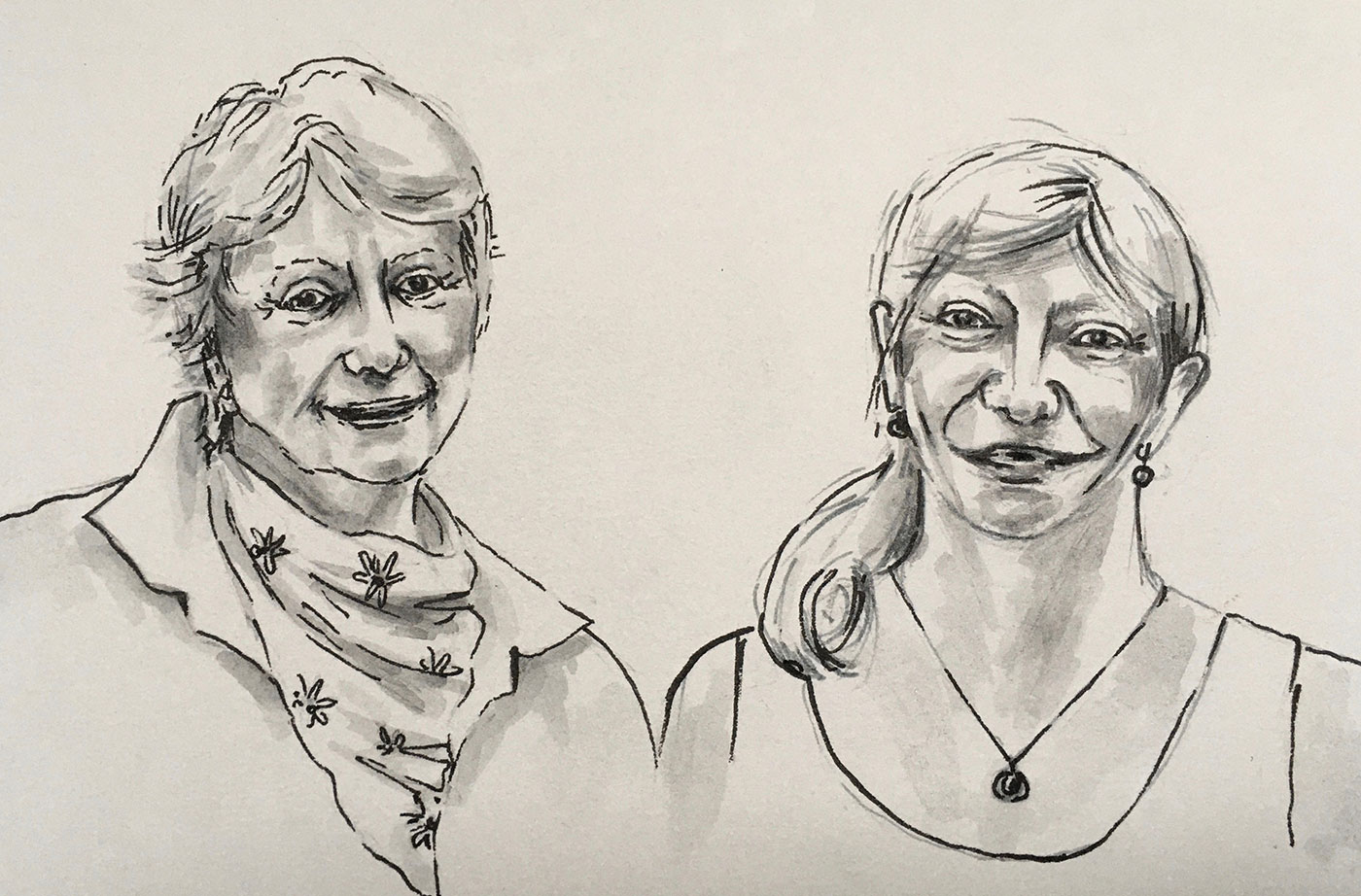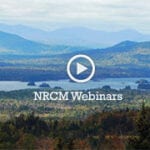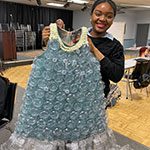This is the first in a two-part blog series that explores the intersection of art and environmental protection with interviews featuring the 2020 visiting artists for Baxter State Park and the Allagash Wilderness Waterway. Read our interview with Allagash visiting artist Michael Vermette.
Those who have visited Baxter State Park know it is an inspiring place rich with history. In fact, Mount Katahdin, the largest mountain in Maine reaching 5,269 feet and located in the park, is a sacred place for Native Americans. To members of the Penobscot Tribe, Katahdin represents the beginning of life, a place of birth and spiritual enlightenment. Countless artists and writers have drawn inspiration from the park as well.
Recognizing how profound of an experience visiting the park can be, in 2009, Baxter State Park established a Visiting Artist Program to provide the opportunity for an artist to live and create art in the park for two weeks in September. This year, Portland-based artist Jill Osgood was selected for the program, and she graciously accepted an interview request from the Natural Resources Council of Maine. Here’s what Jill had to say, fresh out of the North Woods. —NRCM Forests & Wildlife Director Melanie Sturm
Tell us a little about yourself and your art. What prompted you to pursue this path? What is it about art that captivates you? Was there a particular moment when you realized you had a gift?
My name is Jill Osgood, and I am an artist and educator living in Portland, Maine. I moved to Maine 40 years ago to attend the Portland School of Art, and in 2017 I received my BFA from the University of Southern Maine with a concentration in painting and a minor in Book Arts. I like to work in watercolor, ink, and gouache, and often incorporate collage in my work. My paintings and artist’s books mostly reference the natural world in some way, and Maine in particular.
I also like to paint portraits and am a member of the Portland Drawing Society, a group that meets regularly for portrait painting. I work for various nonprofits as a teaching artist in public schools here in Portland as well as Brunswick and Lewiston.
I am also an enthusiastic nature lover. In 2019 I completed the Maine Master Naturalist Program and continue to teach nature journaling to both children and adults. Growing up in the woods of New Hampshire, my parents fostered in me a love for both nature and art. Being an artist and a lover of the natural world has always been a strong part of my identity.
What was it about the Baxter State Park Visiting Artist Program that intrigued you? Was it what you expected? Were there particular challenges and rewards?
In many ways the Baxter visiting artist program was a perfect fit for me. At the University of Southern Maine my senior year focus was loosely based on Thoreau’s Maine Woods. Many of my artist’s books referenced Thoreau’s trips to Maine and other pertinent Maine environmental issues, such as bear hunting, dam removal, and climate change.
I’m not a native Mainer, but Maine is my home. I am completely in love with the romantic history of Maine’s immense wilderness. Having the opportunity to stay in a cabin in the park for two weeks was really a dream come true. I hiked around Kidney Pond and the southern end of the park every day, including a hike up Sentinel Mountain, a wonderful canoe trip across two ponds to visit Big and Little Niagra Falls, and a fantastic hike on the east side of the park to Katahdin Lake.
I met many interesting people from all over the country during my two weeks in the park. Right now, I am working on a book featuring ink portraits of some of the people I met. While Percival Baxter intended for his park to remain “forever wild,” the fact is that more than 60,000 people visit the area every year. I’m intrigued by the relationship between humans and nature, and what wild means to us in the 21st century.

The first set of portraits of people I met while I was there. These will be all bound together in a little book with brief info about the people—first name, where they live, and a brief quote about their experience at the park. This photo is of Martha and Rita from Camden, who have been coming to Baxter for years. They apologized for laughing too loudly, and were staying in the only cabin on the other side of Kidney Pond.
Where did you go in the park? Any favorite spots?
In addition to Sentinel Mountain, which is really a nice little hike for those not wanting to commit to the bigger peaks, and the Niagras, I really enjoyed hiking to the many ponds and exploring the varying habitats. Many folks come to the park just to tackle Katahdin, which is definitely a worthy goal. But there is so much more to see and do.
I liked to walk to Moose Look every sunrise and sunset. It’s right in the Kidney Pond campground and gives you a fantastic view of a part of Kidney Pond that is a marsh. Katahdin is right there, and the sun rises over its shoulder. There are beavers and loons and ducks and kingfishers. There was always something to see.
Did you have any encounters with wildlife?
Oh, yes! I saw two moose on a drive up the Tote Road just past Nesowadnehunk campground. There were loons calling constantly on Kidney Pond, and snowshoe hares everywhere around the cabins. Migrating warblers spent hours feeding in the spruce trees right in front of my cabin. I heard Great Horned Owls calling every night, and one evening an owl enjoyed a hare for its dinner very near to my cabin.
I watched a kestrel try to catch a kingfisher on the marsh, and beavers were busy gathering food for their winter lair. I observed a Black-backed Woodpecker working hard on a dead spruce, Great Blue Herons, Common Mergansers, Ravens, a variety of thrushes and lots of Ruffed Grouse.

A pop up of my cabin at night. The North star was directly overhead!
At the start of my stay there were fireflies, and the fields were always full of big fat dragonflies and late summer butterflies. Red squirrels were everywhere in the campground and the woods. I saw a baby ring-necked snake sunning itself, and many garter snakes, frogs, and toads. On one damp morning, three leopard slugs slithered up onto the old wooden bench on my porch to nibble on the lichen.
My flyfishing friends will be happy to hear that I witnessed brook trout jumping right out of the water on many of the ponds. A nice fat cross spider spun her web on my porch railing every morning, and wolf spiders were in the outhouses. I also experienced some wildlife up close in my cabin — apparently it is a bumper year for rodents, including deer mice!
Were there any experiences during your time at the park that were particularly inspiring for your artwork?
I enjoyed chatting with fellow visitors to the park and am working on a book featuring the people I met during my stay. I also made a bunch of botanical ink paintings that I will bind together into a book. One thing that hit me was the change in color from the beginning of my stay to the end. I arrived on the 5th of September, and two weeks later everything was changing very quickly to yellows and oranges and magenta. We had a frost the last two nights I was there. These colors will be a big part of my botanical paintings, revealing the beauty of this transition from life to a retreat into sleep for winter.

Botanicals done with my own hand made black walnut ink on watercolor patterned paper. These will also be bound together into a book, or series of books.
How do you think your experience will shape you and your work going forward?
I will definitely be cultivating a close relationship with the park, both personally and in my art. I immediately became a member of Friends of Baxter State Park when I got home. I’m already planning my next trip to the park. I would love to visit Baxter in winter to ski and snowshoe. I took a lot of photos and intend to use them as inspiration as well.
Where can people see the artwork you created at Baxter?
I hope to share photos of my work on the Baxter State Park Facebook page and will have them on my Instagram (@JillOsgoodArt) and Facebook pages as well. We’ll see what transpires.










Always fabulous!
Sounds like Jill made the most of her time in the park. Thanks for this post. Now I am inspired to visit Baxter!
What a remarkable opportunity, for Jill and others in the past and future. Rebecca Goodale
So glad to see this!
Wonderful work, keep it up!!!
Sounds like a wonderful experience and the artwork is beautiful